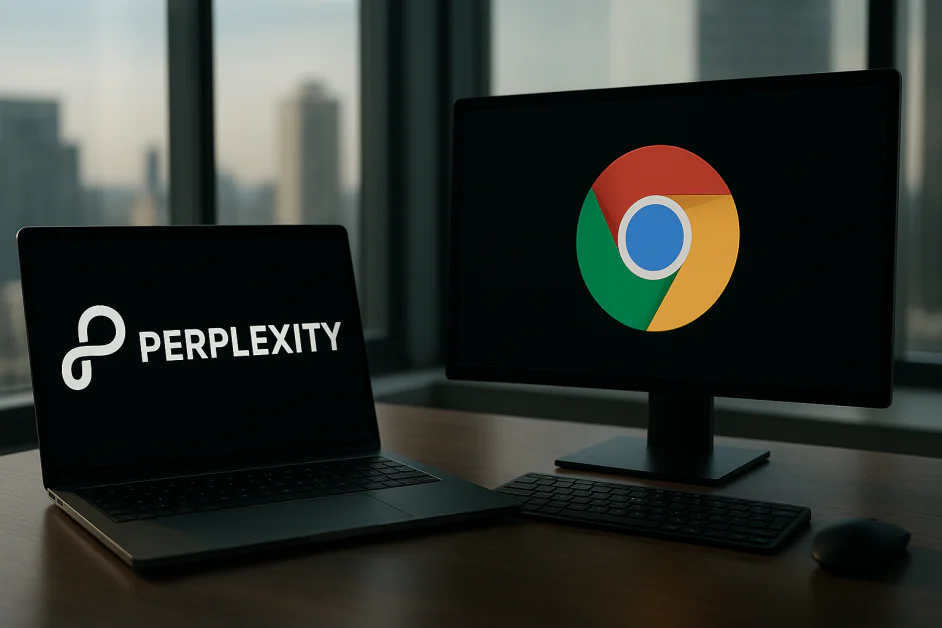विचारक नेता
Perplexity’s Bold Move: What a $34.5B Chrome Bid Means for Digital Brand Strategy

When news broke that AI startup विकलता had placed a $34.5 billion bid to acquire Google’s Chrome browser, the technology and business worlds stopped to take notice. Chrome is not simply a piece of software. It is the gateway to how billions of people discover information, interact with brands, and form impressions online. If this deal were ever to move forward, it would mark one of the most significant shifts in digital access since Google itself replaced portals like Yahoo as the web’s front door.
For those in brand strategy and communications, the implications are profound. Chrome is more than a browser. It is an advertising channel, a reputation filter, and the connective tissue between consumers and the narratives that shape their decisions. To understand what Perplexity’s bid represents, we need to see it not only as a financial headline but as a strategic signal that the way brands reach audiences may be on the verge of dramatic change.
From Search Engines to Answer Engines
Google’s model has long been built on search. Queries deliver a results page, advertisers fight for placement, and brands build content optimized to appear in those results. Perplexity, by contrast, is part of a new wave of एआई-संचालित प्लेटफॉर्म that emphasize direct answers rather than links. The company positions itself as an “answer engine” where AI curates responses to user questions instead of merely pointing to websites.
If Perplexity were to control Chrome, the entire discovery ecosystem would tilt toward conversational AI outputs. Imagine opening your browser and, instead of typing a query into Google, receiving a synthesized, sourced answer immediately at the top of the screen. For brands, this means the traditional game of एसईओ may give way to a more complex battle: becoming the cited source that AI relies on to construct answers.
For communications professionals, the adjustment would be significant. Instead of optimizing for keywords, the emphasis would shift toward citation worthiness. Brands would need to ensure their owned content, research, and thought leadership are authoritative enough to be referenced by AI models in real time. This raises the bar on credibility. It also underscores why investing in original studies, clear data, and well-documented expertise has become an essential communications strategy.
Lessons from Brands Already Caught in AI’s Crosshairs
के मामले पर विचार करें CNET when it experimented with AI-written content in 2023. Early articles contained factual errors, leading to public criticism and damaged trust. The incident showed how unforgiving audiences can be when AI-powered content lacks credibility. If AI becomes the gatekeeper of answers within Chrome, brands that fail to publish transparent, verifiable material risk not being cited at all.
On the flip side, companies like नाइके have demonstrated how leveraging AI tools with a clear creative vision can elevate campaigns and strengthen reputation. Nike’s use of generative AI in advertising was not simply about technology; it was about aligning innovation with the brand’s longstanding narrative of empowerment. That type of approach is exactly what will earn placement in an AI-curated environment, where algorithms reward relevance, authority, and resonance.
The New Currency of Trust and Authority
In this potential new world, brand authority becomes the most valuable currency. Chrome under Perplexity would likely prioritize sources that demonstrate expertise, experience, and trust. This is consistent with how Google itself has shifted toward ईईएटी principles (Expertise, Experience, Authoritativeness, Trustworthiness) in ranking content.
For communicators, this means press releases alone will not suffice. A brand must show thought leadership through bylines in reputable publications, research partnerships with universities, and transparent reporting on impact. It also means reputation management strategies must expand to consider how AI models interpret sentiment, accuracy, and relevance.
जब संकट breaks, for instance, AI-driven platforms will synthesize public statements, media coverage, and historical data in real time. If a brand has not already established itself as transparent and responsive, the AI-curated narrative may skew toward negative interpretations. This makes preparation and proactive reputation-building more critical than ever.
B2B Strategy in an AI Browser Future
While much of the focus around TikTok, Instagram, or YouTube is on consumer-facing brands, the implications for B2B companies are equally serious. Decision makers at Fortune 500 firms or mid-market enterprises do not leave their human behaviors at the office door. They search, they scroll, and increasingly they rely on AI summaries to cut through complexity.
If Chrome were to adopt an AI-first interface, B2B communications teams would need to produce material that AI can parse, cite, and surface. Whitepapers can no longer sit behind gated forms if the goal is to appear in an answer engine. Case studies must be structured in ways that allow algorithms to extract proof points. In short, B2B content must serve a dual purpose: persuading human executives and providing machine-readable evidence that earns inclusion in AI responses.
Microsoft’s embrace of AI within सह पायलट offers a glimpse of this direction. In many workplaces, Copilot already drafts presentations, summarizes reports, and shapes internal messaging. If Chrome integrates Perplexity’s AI at a consumer level, the same behaviors will carry over to how executives assess vendors, partners, and competitors.
Strategy Beyond the Bid
Whether or not Perplexity succeeds in acquiring Chrome, the signal is unmistakable. Browsers are no longer neutral gateways. They are becoming curated environments where AI shapes what users see first and how they interpret information. For communications professionals, the takeaway is clear. Strategies must evolve beyond traditional media relations and keyword optimization.
The brands that will thrive in this environment are those that:
- Publish original, credible content that AI trusts.
- Engage proactively in industry conversations to establish वैचारिक नेतृत्व.
- Prepare crisis protocols that anticipate AI-driven narrative formation.
- Align creative use of AI with their brand’s enduring values.
This is not about abandoning tried-and-true communications disciplines. It is about expanding them to reflect a new layer of influence: the AI mediator sitting between a user’s query and the brand’s message.
A Wake-Up Call for Brand Leaders
Perplexity’s $34.5 billion bid for Chrome may or may not come to fruition, but it should be seen as a wake-up call for every brand strategist. The future of digital communication is not just about reaching audiences directly. It is about shaping the sources and signals that AI relies on to tell stories on our behalf.
For brand leaders and communications professionals, this is both a challenge and an opportunity. Those who invest in credibility, clarity, and creativity will see their narratives amplified. Those who neglect these foundations risk being left out of the answers that billions of users receive every day.
In this moment, the message is simple: the gatekeepers are changing, and so must we.












